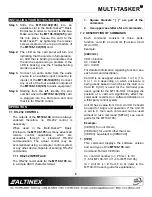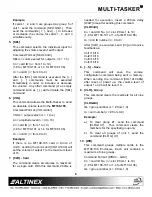
MULTI-TASKER
6
INSTALLING YOUR MT108-104/(105)
6
Step 1.
Slide the
MT108-104/(105)
into an
available slot in the Multi-Tasker™ Basic
Enclosure in order to connect to the bus.
Make sure that the
MT108-104/(105)
card
fits into place. Secure the card to the
Multi-Tasker™ by tightening the retainer
screws located on the top and bottom of
the
MT108-104/(105)
card.
Step 2.
The LED on the card panel will turn red
indicating that the card is in full operation.
An LED that is blinking red indicates that
the card is experiencing a problem. If the
LED is blinking, see the Troubleshooting
Guide in section 8.
Step 3.
Connect an audio cable from the audio
source to an available input connector (4
inputs) of the
MT108-104/(105)
. Connect
any or all of the four available outputs of
the
MT108-104/(105)
to audio equipment.
Step 4.
Starting from the left, identify the slot
number where the
MT108-104/(105)
card
is plugged into the Enclosure and note
that it is for RS-232 control.
OPERATION
7
7.1 RS-232 CONTROL
The outputs of the
MT108-104
card
are always
enabled; therefore, no RS-232 control is
necessary.
When used in the Multi-Tasker™ Basic
Enclosure, the
MT108-105
has many advanced
remote control capabilities, which are
accessible through a standard RS-232
communication. The actual control may be
accomplished using a computer control system
or any other device capable of sending RS-232
commands.
7.1.1 RS-232 INTERFACE
The RS-232 commands for the
MT108-105
are
in a simple ASCII character format.
1.
Square brackets “[ ]” are part of the
command.
2.
Use uppercase letters for all commands.
7.2 DESCRIPTION OF COMMANDS
Each command consists of three parts:
function, card ID, and unit ID. [Function, Card
ID, Unit ID].
Example:
[VERC3U2]
VER = function
C3 = Card ID
U2 = Unit ID
For detailed information regarding function, see
each command description.
Card ID is an assigned value from 1 to 19, (1 to
8 or 1 to 4 depending on which enclosure is
being used); based on which slot the card is in.
Card ID 0 (C0) is used for the controller (see
user’s guide for the MT100-100). Changing the
position of a card will significantly affect the
commands recorded on software definitions or
a third party control system.
Unit ID has a value from 0 to 9. Unit ID 0 should
be used for single unit operation. If the Unit ID
is set to 0, then each command can be used
without Ui (use command [SETU0]; see user’s
guide for the MT100-100).
Example:
[VERC3]: for unit ID zero
[VERC3Ui]: for unit ID other than zero
[VERC3]: equivalent to [VERC3U0]
1. [VER]
This command displays the software version
and card type of the
MT108-105
card.
Command Format: VERCnUi
Cn = card ID number (n = # from 1 to 19)
(1-8 for MT100-101 or 1-4 for MT100-106)
Ui = Unit ID (i = # from 0 to 9) (refer to the
MT100-100 user’s guide for explanation)











